Woodcuts: Difference between revisions
No edit summary |
|||
| (6 intermediate revisions by one other user not shown) | |||
| Line 1: | Line 1: | ||
[[File:Woodcut blurb.jpg|400px|thumb|right]] The predominant notion of the historical track of modern science is teleological: this narrative holds that as time passed, accuracy naturally increased, as the pursuit of knowledge solidified in form and texts could increasingly be fact-checked. The primary form of illustration in printed books until the seventeenth century was the woodcut,<ref> Bamber Gascoigne, ''How to Identify Prints: A Complete Guide to Manual and Mechanical Processes From Woodcut to Ink Jet'' (New York, N.Y.: Thames and Hudson, 1986), 5a,b.</ref> particularly in illustrated reference works. My essay explores the idea of woodcut book illustration as representative of a burgeoning pursuit of accuracy and therefore of the rise of modern science in the Early Modern period. Through two case studies, Leonhart Fuchs’s ''De historia stirpium'' (1542) and Pietro Andrea Mattioli’s commentary on ''Materia medica'', I will attempt to navigate an Early Modern concept of accuracy through the woodcuts of performatively pedagogical books: at first through an assessment of these illustrations’ “accuracy,” but primarily through an interpretation of the work illustrations do in the greater phenomenon of the material book. <br /> | [[File:Woodcut blurb.jpg|400px|thumb|right]] The predominant notion of the historical track of modern science is teleological: this narrative holds that as time passed, accuracy naturally increased, as the pursuit of knowledge solidified in form and texts could increasingly be fact-checked. The primary form of illustration in printed books until the seventeenth century was the woodcut,<ref> Bamber Gascoigne, ''How to Identify Prints: A Complete Guide to Manual and Mechanical Processes From Woodcut to Ink Jet'' (New York, N.Y.: Thames and Hudson, 1986), 5a,b.</ref> particularly in illustrated reference works. My essay explores the idea of woodcut book illustration as representative of a burgeoning pursuit of accuracy and therefore of the rise of modern science in the Early Modern period. Through two case studies, Leonhart Fuchs’s ''De historia stirpium'' (1542) and Pietro Andrea Mattioli’s commentary on ''Materia medica'', I will attempt to navigate an Early Modern concept of accuracy through the woodcuts of performatively pedagogical books: at first through an assessment of these illustrations’ “accuracy,” but primarily through an interpretation of the work illustrations do in the greater phenomenon of the material book. <br /> | ||
In the most basic terms, a woodcut, also known as a woodblock, is a kind of relief print, in which material is removed from a plate to leave a raised design that will then be inked and printed. In woodblocks, material is carved away from a relatively soft plank of wood, traditionally from trees such as pear, apple, and holly.<ref> Edward Hodnett, ''Five Centuries of English Book Illustration'' (Aldershot, England: Scolar Press, 1988), 10.</ref> | In the most basic terms, a woodcut, also known as a woodblock, is a kind of relief print, in which material is removed from a plate to leave a raised design that will then be inked and printed. In woodblocks, material is carved away from a relatively soft plank of wood, traditionally from trees such as pear, apple, and holly.<ref> Edward Hodnett, ''Five Centuries of English Book Illustration'' (Aldershot, England: Scolar Press, 1988), 10.</ref> Woodblock printing had existed in China since the 9th century,<ref>Gascoigne, ''Identify Prints'', 5a,b.</ref>and had been used in Europe since the early fifteenth century to print playing cards, textile patterns, and blockbooks,<ref>Hodnett, ''Five Centuries'', 10.</ref> in which both the text and the image are carved from the block. The first dated woodcut-illustrated book printed in Europe was the German ''Der Edelstein'' in 1461.<ref>Paul Needham, "Prints in the Early Printing Shops." ''Studies in the History of Art 75'' (2009), 55. </ref> The first European herbal, the ''Puch der Natur'' of Konrad of Megenberg, would be printed in 1475.<ref>Wilfrid Blunt and Sandra Raphael, ''The Illustrated Herbal'' (New York, N.Y.: Thames and Hudson: Metropolitan Museum of Art, 1979), 113.</ref> Woodcut is distinguished from wood engraving, a similar technique on planks cut against the grain, which achieves a much different visual result and would first appear in books as late as the seventeenth century.<ref>Gascoigne, ''Identify Prints'', 6a.</ref> <br /> | ||
Woodcuts would eventually become the primary method of illustrating reference works. The introduction of image reproduction technology to books has, like that of moveable type, been understood as responsible for a “communications revolution.”<ref> Elizabeth L. Eisenstein, “Defining the Initial Shift,” ''The Printing Revolution In Early Modern Europe''. 2nd ed. (Canto classics ed. Cambridge: Cambridge University Press, 2012), 24.</ref> Elizabeth Eisenstein, in ''The Printing Revolution of Early Modern Europe'', argues that the incorporation of woodcuts into print “helped to revolutionize technical literature:”<ref>Eisenstein, “Defining,” 24.</ref> | Woodcuts would eventually become the primary method of illustrating reference works. The introduction of image reproduction technology to books has, like that of moveable type, been understood as responsible for a “communications revolution.”<ref> Elizabeth L. Eisenstein, “Defining the Initial Shift,” ''The Printing Revolution In Early Modern Europe''. 2nd ed. (Canto classics ed. Cambridge: Cambridge University Press, 2012), 24.</ref> Elizabeth Eisenstein, in ''The Printing Revolution of Early Modern Europe'', argues that the incorporation of woodcuts into print “helped to revolutionize technical literature:”<ref>Eisenstein, “Defining,” 24.</ref> | ||
Even though block prints and letterpress may have originated in separate innovations and were initially used for diverse purposes, the two techniques soon became intertwined. The use of typography for texts led to that of xylography for illustration.<ref>Eisenstein, “Defining,” 26.</ref> | Even though block prints and letterpress may have originated in separate innovations and were initially used for diverse purposes, the two techniques soon became intertwined. The use of typography for texts led to that of xylography for illustration.<ref>Eisenstein, “Defining,” 26.</ref> | ||
Preceding Eisenstein is William Ivins, who argues in unambiguous terms that the “exact repetition of pictorial statements has had incalculable effects upon knowledge and thought, upon science and technology, of every kind.”<ref>Ivins, William Mills, ''Prints and Visual Communication''. (Cambridge, Mass.: M.I.T. Press, 1953, 1969), 3.</ref> In his view of the technology, he emphasizes the “exactly repeatable pictorial statement” as responsible for massive shifts toward a more capable, more accurate and far-reaching scientific method.<ref>Ivins, ''Prints'', 3.</ref> These deterministic arguments dominate the conception of woodcuts’ role in the history of science. They paint woodcut illustration as a utilitarian tool for knowledge copying, a type of Early Modern photograph, saving science from the inaccuracies of hand illustration and placing it in a teleological trajectory toward accuracy. Herbals form part of this teleological lineage, having existed for millennia before the advent of print but increasing exponentially in numbers afterward.<br /> | Preceding Eisenstein is William Ivins, who argues in unambiguous terms that the “exact repetition of pictorial statements has had incalculable effects upon knowledge and thought, upon science and technology, of every kind.”<ref>Ivins, William Mills, ''Prints and Visual Communication''. (Cambridge, Mass.: M.I.T. Press, 1953, 1969), 3.</ref> In his view of the technology, he emphasizes the “exactly repeatable pictorial statement” as responsible for massive shifts toward a more capable, more accurate and far-reaching scientific method.<ref>Ivins, ''Prints'', 3.</ref> These deterministic arguments dominate the conception of woodcuts’ role in the history of science. They paint woodcut illustration as a utilitarian tool for knowledge copying, a type of Early Modern photograph, saving science from the inaccuracies of hand illustration and placing it in a teleological trajectory toward accuracy. Herbals, books that categorized plants in a time where botany and pharmacy were practically interchangeable, form part of this teleological lineage, having existed for millennia before the advent of print but increasing exponentially in numbers afterward.<br /> | ||
About as old as illustrated printed herbals, however, are debates over their accuracy. Sixteenth-century physicians contended over both the accuracy and the necessity of pictures in instruction. This was due, according to Sachiko Kusukawa, to disagreements in interpretations of ancient texts. Explicit disapproval by ancients such as Galen and Pliny the Elder and implicit objections by Dioscorides were weighted varyingly by different physicians. While some, like Fuchs and Mattioli, used images to “resolve discrepancies amongst the ancients as well as between the ancients and their own contemporaries,” others “made recourse to philology, history, or morality.”<ref>Sachiko Kusukawa, ''Picturing the Book of Nature: Image, Text, and Argument In Sixteenth-Century Human Anatomy and Medical Botany'' (Chicago: University of Chicago Press, 2012), 20.</ref> Not only were the pictures themselves disputed, but among those who agreed on their indispensability, contention arose over the effect of the artist’s hand on accuracy. While physicians themselves were not expected to be able to draw, a picture’s accuracy came to depend on the level of physician’s supervision over the artist.<ref>Kusukawa, ''Picturing'', 24.</ref> We see evidence of this facet of authority in one of the final pages of ''De historia stirpium'', which depicts the artists working under Fuchs’s close watch.<br /> | About as old as illustrated printed herbals, however, are debates over their accuracy. Sixteenth-century physicians contended over both the accuracy and the necessity of pictures in instruction. This was due, according to Sachiko Kusukawa, to disagreements in interpretations of ancient texts. Explicit disapproval by ancients such as Galen and Pliny the Elder and implicit objections by Dioscorides were weighted varyingly by different physicians. While some, like Fuchs and Mattioli, used images to “resolve discrepancies amongst the ancients as well as between the ancients and their own contemporaries,” others “made recourse to philology, history, or morality.”<ref>Sachiko Kusukawa, ''Picturing the Book of Nature: Image, Text, and Argument In Sixteenth-Century Human Anatomy and Medical Botany'' (Chicago: University of Chicago Press, 2012), 20.</ref> Not only were the pictures themselves disputed, but among those who agreed on their indispensability, contention arose over the effect of the artist’s hand on accuracy. While physicians themselves were not expected to be able to draw, a picture’s accuracy came to depend on the level of physician’s supervision over the artist.<ref>Kusukawa, ''Picturing'', 24.</ref> We see evidence of this facet of authority in one of the final pages of ''De historia stirpium'', which depicts the artists working under Fuchs’s close watch.<br /> | ||
| Line 12: | Line 12: | ||
In Leonhart Fuchs’s 1542 herbal ''De historia stirpium'', we see a prime example of the affordances of woodcuts in early reference literature. Fuchs’s herbal accompanies each description of a plant species with a full-page woodcut illustration. This amounts to more than 500 woodcuts, each used only once, in the more than 900 folios of the work. <br /> | In Leonhart Fuchs’s 1542 herbal ''De historia stirpium'', we see a prime example of the affordances of woodcuts in early reference literature. Fuchs’s herbal accompanies each description of a plant species with a full-page woodcut illustration. This amounts to more than 500 woodcuts, each used only once, in the more than 900 folios of the work. <br /> | ||
[[File:Fuchs rectangle cut.jpg|400px|thumb|left|Figure 1. Left: example of rectangularization in ''De historia stirpium''. Right: “RAPVM” roots cut off.]] By contemporary standards, the Fuchs illustrations fall short of accuracy in a number of ways. Most of these can be attributed to the existence of an artistic ideal, however subtle. Throughout the book, several artistic decisions exhibit a divergence from a simple copy of the observed plant. The most obvious of these is the rectangularization, in which plants’ extremities are illustrated as bent in order to fit inside the woodblock (sometimes, very rarely, parts of the plant are just cut at the border of the plate, as in the “RAPVM” of page 213; see Figure 1). Rectangularization has the effect of a kind of material landscaping on the page: the natural world is bent and cut to fit an artistic ideal and the technologies affordances?. This creates ambiguity as to the actual direction of the leaves or roots. For example, both the “ACORVM” and the “ANETHVM” are illustrated with roots that bend sideways (see Figure 2). While the “ANETHVM” plant does not naturally have bent roots, and is portrayed as such to fit the block, the “ACORVM” plant does. In one woodcut the choice to bend is one of faithfulness to observed reality and in the other it is one of faithfulness to the design of the page. This ambiguity exemplifies one of the practical effects of the technology at hand: rectangularization allowed for the use of a single plate, which would have saved both time and money.<ref>Blunt and Raphael, ''Illustrated Herbal'', 126.</ref> Practically, projections of time and cost played a role in determining the final particulars of portrayed knowledge. We see that the illustrations are necessarily mediated and do not stand alone as vessels of knowledge. <br /> [[File:Acorvm anethvm new.jpg|400px|thumb|right|Figure 2. “ACORVM”and “ANETHVM” in ''De historia stirpium'' (1542).]] | [[File:Fuchs rectangle cut.jpg|400px|thumb|left|Figure 1. Left: example of rectangularization in ''De historia stirpium''. Right: “RAPVM” roots cut off.]] By contemporary standards, the Fuchs illustrations fall short of accuracy in a number of ways. Most of these inaccuracies can be attributed to the existence of an artistic ideal, however subtle. Throughout the book, several artistic decisions exhibit a divergence from a simple copy of the observed plant. The most obvious of these is the rectangularization, in which plants’ extremities are illustrated as bent in order to fit inside the woodblock (sometimes, very rarely, parts of the plant are just cut at the border of the plate, as in the “RAPVM” of page 213; see Figure 1). Rectangularization has the effect of a kind of material landscaping on the page: the natural world is bent and cut to fit an artistic ideal and the technologies affordances?. This creates ambiguity as to the actual direction of the leaves or roots. For example, both the “ACORVM” and the “ANETHVM” are illustrated with roots that bend sideways (see Figure 2). While the “ANETHVM” plant does not naturally have bent roots, and is portrayed as such to fit the block, the “ACORVM” plant does. In one woodcut the choice to bend is one of faithfulness to observed reality and in the other it is one of faithfulness to the design of the page. This ambiguity exemplifies one of the practical effects of the technology at hand: rectangularization allowed for the use of a single plate, which would have saved both time and money.<ref>Blunt and Raphael, ''Illustrated Herbal'', 126.</ref> Practically, projections of time and cost played a role in determining the final particulars of portrayed knowledge. We see that the illustrations are necessarily mediated and do not stand alone as vessels of knowledge. <br /> [[File:Acorvm anethvm new.jpg|400px|thumb|right|Figure 2. “ACORVM”and “ANETHVM” in ''De historia stirpium'' (1542).]] | ||
Fuchs’s notion of an ideal further makes subjective | Fuchs’s notion of an ideal further makes subjective the information that is presented as objective. His aversion to strict naturalism in scientific texts informs both the style and the content of the final illustrations. The illustrations have no shading, failing to indicate a possible light source and therefore a range of possible textures. This technique, meant by Fuchs to make the images as clear to interpret as possible,<ref>Kusukawa, ''Picturing'', 109.</ref> further obfuscates in that the “flat, schematic appearance […] can be visually confusing where the overlapping parts are unmodulated by shading.”<ref>Gill Saunders, ''Picturing Plants: an Analytical History of Botanical Illustration'' (Berkeley: University of California Press in association with the Victoria and Albert Museum, London, 1995), 26.</ref> These are not photographic representations of the specimens. The illustrations further stray from a strict, naturalistic accuracy in that Fuchs chose not to represent individual, observed specimens, but to omit what he interpreted as imperfections to produce a conglomerate representation of the whole species.<ref>Saunders, ''Picturing Plants'', 20.</ref> Thus, the final image is not a simple copy of an observed reality, but a synthesis that is necessarily interpretive, and therefore subjective. <br /> | ||
However, through these subjective decisions toward an ideal, as well as through a number of material, bibliographic choices, Fuchs’s herbal seeks to define rather than to defy a scientific accuracy. According to Kusukawa, these illustrations work not as mere visual representations of a thing, but as “visual arguments” that “len[d] authority” to Fuchs’s scientific views.<ref>Kusukawa, ''Picturing'', 3.</ref> They were used to “make generalizing arguments, discuss complete or ideal objects, and claim authority in matters of knowledge.”<ref>Kusukawa, ''Picturing'', 3.</ref> After all, Fuchs was a field botanist<ref>Blunt and Raphael, ''Illustrated Herbal'', 125.</ref>; he created ''De historia stirpium'' out of frustration over German medicinal ignorance.<ref>rank J. Anderson, ''An Illustrated History of the Herbals'' (New York: Columbia University Press, 1977), 137.</ref> He wanted an accuracy he wasn’t finding elsewhere. His choices meet an audience expecting not to find photographic reality on the page, but to be convinced, and his “visual arguments” were part of the convincing. Thus, the choice to produce a generalized representation of a species is an argumentative one; in a sense, “this is ''the'' plant, not ''a'' plant.” As, according to Valerie Traub, Early Modern cartographers sought to map the “habit” of a people,<ref> Valerie Traub, “Mapping the Global Body,” ''Early Modern Visual Culture: Representation, Race, Empire In Renaissance England''. (Philadelphia: University of Pennsylvania Press, 2000), 51.</ref> so too did Fuchs seek to present the “character and habit” of a plant species.<ref> Blunt and Raphael, ''Illustrated Herbal'', 126.</ref> This practice of generalization would come to be preferred over minute specificity in later herbals.<ref> Saunders, ''Picturing Plants'', 22.</ref> Fuchs, then, defined this facet of accuracy not only for himself, but for herbalists to come. <br /> | However, through these subjective decisions toward an ideal, as well as through a number of material, bibliographic choices, Fuchs’s herbal seeks to define rather than to defy a scientific accuracy. According to Kusukawa, these illustrations work not as mere visual representations of a thing, but as “visual arguments” that “len[d] authority” to Fuchs’s scientific views.<ref>Kusukawa, ''Picturing'', 3.</ref> They were used to “make generalizing arguments, discuss complete or ideal objects, and claim authority in matters of knowledge.”<ref>Kusukawa, ''Picturing'', 3.</ref> After all, Fuchs was a field botanist<ref>Blunt and Raphael, ''Illustrated Herbal'', 125.</ref>; he created ''De historia stirpium'' out of frustration over German medicinal ignorance.<ref>rank J. Anderson, ''An Illustrated History of the Herbals'' (New York: Columbia University Press, 1977), 137.</ref> He wanted an accuracy he wasn’t finding elsewhere. His choices meet an audience expecting not to find photographic reality on the page, but to be convinced, and his “visual arguments” were part of the convincing. Thus, the choice to produce a generalized representation of a species is an argumentative one; in a sense, “this is ''the'' plant, not ''a'' plant.” As, according to Valerie Traub, Early Modern cartographers sought to map the “habit” of a people,<ref> Valerie Traub, “Mapping the Global Body,” ''Early Modern Visual Culture: Representation, Race, Empire In Renaissance England''. (Philadelphia: University of Pennsylvania Press, 2000), 51.</ref> so too did Fuchs seek to present the “character and habit” of a plant species.<ref> Blunt and Raphael, ''Illustrated Herbal'', 126.</ref> This practice of generalization would come to be preferred over minute specificity in later herbals.<ref> Saunders, ''Picturing Plants'', 22.</ref> Fuchs, then, defined this facet of accuracy not only for himself, but for herbalists to come. <br /> | ||
| Line 23: | Line 23: | ||
==Pietro Andrea Mattioli: Commentary on the ''Materia Medica'', (1563, 1565, 1568, 1600)== | ==Pietro Andrea Mattioli: Commentary on the ''Materia Medica'', (1563, 1565, 1568, 1600)== | ||
Of the most well-known herbals, both now and in its time, is Pietro Andrea Mattioli’s commentary on the ''Materia medica'' of ancient Greek physician Dioscorides (date). Mattioli’s herbal, like Fuchs's, takes full advantage of woodcut technology for reference purposes. Almost every page of the more than nine hundred folios (in some cases, as in the 1568 Latin edition, more than one thousand) contains a woodcut illustration. Further, through its more than 60 editions and dozens of thousands of | Of the most well-known herbals, both now and in its time, is Pietro Andrea Mattioli’s commentary on the ''Materia medica'' of ancient Greek physician Dioscorides (date). Mattioli’s herbal, like Fuchs's, takes full advantage of woodcut technology for reference purposes. Almost every page of the more than nine hundred folios (in some cases, as in the 1568 Latin edition, more than one thousand) contains a woodcut illustration. Further, through its more than 60 editions and dozens of thousands of copies,<ref> John Bidwell, ''Mattioli's Herbal: A Short Account of Its Illustrations, with a Print From an Original Woodblock'' (New York: Pierpont Morgan Library, 2003), 5.</ref> the Mattioli herbal exemplifies the extreme reproducibility of the woodcut and its potential to create uniformity among texts. <br /> | ||
Despite Mattioli’s resulting fame as a celebrity doctor after the success of his herbal,<ref> Anderson, ''Illustrated History'', 164.</ref> by Fuchs’s standards, this herbal would’ve been a disaster of scientific accuracy. In comparing the two, we see flaws in the notion (argument) that scientific illustrations only increased in photographic accuracy as time passed. Mattioli had no working knowledge of plants.<ref>Anderson, ''Illustrated History'', 168.</ref> Often, he had no specimens to work from, would accept dried plants that then had to be reconstituted to observe, and would copy illustrations with no means of checking with the original plant.<ref>Anderson, ''Illustrated History'', 168.</ref> Further, the illustrations in Mattioli’s herbal are as beautiful as they are inaccurate. Throughout the work, it is often obvious that the “illustrator has not properly understood the construction” of the specimens.<ref> Saunders, ''Picturing Plants'', 31.</ref> These illustrations held great appeal for the many thousands of contemporary readers,<ref> Anderson, ''Illustrated History'', 170.</ref> and were perhaps made with this readership in mind; we see here, more so than in Fuchs’s, illustrations toward an artistic ideal. <br /> | Despite Mattioli’s resulting fame as a celebrity doctor after the success of his herbal,<ref> Anderson, ''Illustrated History'', 164.</ref> by Fuchs’s standards, this herbal would’ve been a disaster of scientific accuracy. In comparing the two, we see flaws in the notion (argument) that scientific illustrations only increased in photographic accuracy as time passed. Mattioli had no working knowledge of plants.<ref>Anderson, ''Illustrated History'', 168.</ref> Often, he had no specimens to work from, would accept dried plants that then had to be reconstituted to observe, and would copy illustrations with no means of checking with the original plant.<ref>Anderson, ''Illustrated History'', 168.</ref> Further, the illustrations in Mattioli’s herbal are as beautiful as they are inaccurate. Throughout the work, it is often obvious that the “illustrator has not properly understood the construction” of the specimens.<ref> Saunders, ''Picturing Plants'', 31.</ref> These illustrations held great appeal for the many thousands of contemporary readers,<ref> Anderson, ''Illustrated History'', 170.</ref> and were perhaps made with this readership in mind; we see here, more so than in Fuchs’s, illustrations toward an artistic ideal. <br /> | ||
| Line 29: | Line 29: | ||
[[File:Color bleed new new.jpg|300px|thumb|left|Figure 5: detail of “VERBALCUM” print from 1600 German edition of Mattioli’s commentary.]] [[File:Woodcut noise both.jpg|300px|thumb|right|Figure 6. Left: detail of “VERBALCUM” print from 1568 Latin edition of Mattioli’s commentary. Right: detail of “VERBALCUM” print from 1565 Latin edition of Mattioli’s commentary.]] [[File:Verbalcum white red.jpg|300px|thumb|right|Figure 7. Upper: “VERBALCUM” print from 1563 German edition of Mattioli’s commentary. Lower: “VERBALCUM” print from 1600 German edition of Mattioli’s commentary.]] Artistry seems to take the reins in much of the illustrations. Mattioli’s herbal is infamous for its rectangularization.<ref> Saunders, ''Picturing Plants'', 31.</ref> Roots and leaves conspicuously turn inwards and press against an invisible border in nearly every illustration. Further, in stark contrast to Fuchs’s simplifying illustrations, here the “artist has over-elaborated his subject” to the point of confusion.<ref> Saunders, ''Picturing Plants'', 33.</ref> The pictures are heavily shaded and textured to point of obfuscation. So too do the colors conceal. The paints bleed past woodcut borders and obscure outlines by nature of their thickness (see Figure 5). Further, different editions differ in illustrations of the same plant. Sometimes this is subtle, as in the 1565 and 1568 Latin editions. One can see that the same woodblock of the “VERBALCUM” has been printed with different pressures: the 1565 picks up noise from the plate that isn’t apparent in the 1568 (see Figure 6). More conspicuously, the different editions are, in a way revelatory of the lack of supervision across editions and languages, colored differently to represent the same plants. For example, the 1600 German edition paints the “VERBALCUM” flowers red where in the 1563 German edition they are an almost imperceptible light yellow (see Figure 7). In these two woodcuts we further see differences in the “accuracy” of illustrations throughout editions. The 1600 edition of the “Verbalcum” woodcut, an imitation of the 1563 “Verbalcum” and exactly half its size, changes not only the color, but the shape of the flowers. Where in the 1563 they are rounded, in the 1600 they are clearly pointed (see Figure 7). Which is more accurate? Which should the Early Modern reader question? It is unlikely that an Early Modern reader would have had access to more than one of Mattioli’s herbals. The woodcuts in each copy, then, stand alone as unquestionable, authoritative representations to their readers. <br /> | [[File:Color bleed new new.jpg|300px|thumb|left|Figure 5: detail of “VERBALCUM” print from 1600 German edition of Mattioli’s commentary.]] [[File:Woodcut noise both.jpg|300px|thumb|right|Figure 6. Left: detail of “VERBALCUM” print from 1568 Latin edition of Mattioli’s commentary. Right: detail of “VERBALCUM” print from 1565 Latin edition of Mattioli’s commentary.]] [[File:Verbalcum white red.jpg|300px|thumb|right|Figure 7. Upper: “VERBALCUM” print from 1563 German edition of Mattioli’s commentary. Lower: “VERBALCUM” print from 1600 German edition of Mattioli’s commentary.]] Artistry seems to take the reins in much of the illustrations. Mattioli’s herbal is infamous for its rectangularization.<ref> Saunders, ''Picturing Plants'', 31.</ref> Roots and leaves conspicuously turn inwards and press against an invisible border in nearly every illustration. Further, in stark contrast to Fuchs’s simplifying illustrations, here the “artist has over-elaborated his subject” to the point of confusion.<ref> Saunders, ''Picturing Plants'', 33.</ref> The pictures are heavily shaded and textured to point of obfuscation. So too do the colors conceal. The paints bleed past woodcut borders and obscure outlines by nature of their thickness (see Figure 5). Further, different editions differ in illustrations of the same plant. Sometimes this is subtle, as in the 1565 and 1568 Latin editions. One can see that the same woodblock of the “VERBALCUM” has been printed with different pressures: the 1565 picks up noise from the plate that isn’t apparent in the 1568 (see Figure 6). More conspicuously, the different editions are, in a way revelatory of the lack of supervision across editions and languages, colored differently to represent the same plants. For example, the 1600 German edition paints the “VERBALCUM” flowers red where in the 1563 German edition they are an almost imperceptible light yellow (see Figure 7). In these two woodcuts we further see differences in the “accuracy” of illustrations throughout editions. The 1600 edition of the “Verbalcum” woodcut, an imitation of the 1563 “Verbalcum” and exactly half its size, changes not only the color, but the shape of the flowers. Where in the 1563 they are rounded, in the 1600 they are clearly pointed (see Figure 7). Which is more accurate? Which should the Early Modern reader question? It is unlikely that an Early Modern reader would have had access to more than one of Mattioli’s herbals. The woodcuts in each copy, then, stand alone as unquestionable, authoritative representations to their readers. <br /> | ||
[[File:Mattioli front and clasps.jpg|300px|thumb|right|Figure 8. 1563 German edition of Mattioli’s commentary.]] Despite their major differences, the Mattioli herbal and ''De historia stirpium'' define accuracy in very similar ways. As Fuchs worked to update German medicinal knowledge, Mattioli sought to update Dioscorides’s ''Materia medica'' with contemporary information.<ref> Anderson, ''Illustrated History'', 170.</ref> Explicit in the opening paratexts, this endeavor, like Fuchs’s woodcut portrait, works in two ways to validate the text. It validates Mattioli as both a sound follower of ancient wisdom and a contemporary physician presenting the most up-to-date information possible. His authorship, in turn, validates the text. Likewise, the two herbals assert authority through similar material decisions. The Mattioli herbal is a massive book (see Figure 8): the 1568 Latin edition surpasses 1000 folios; Blunt’s and Raphael’s The Illustrated Herbals warns that “only those accustomed to let their Great Dane sleep on their bed should contemplate choosing the Mattioli folio [...] for a bedside book.”<ref> Blunt and Raphael, ''Illustrated Herbal'', 133.</ref> Nearly every page in the massive text is populated by an illustration, this overwhelm of images further contributing to a sensation of abundance. Further, not only is it physically impressive and heavily illustrated, but it also asserts authority in its binding: the 1563 edition is bound in parchment and embossed with an intricate design (see Figure 8). The hard covers are held together by metal clasps that, at least in my experience, require more than one reader to undo (see Figure 8). Finally, like in De historia, the copious amounts of information are indexed extensively. There is a lengthy index of plant species and, at least in the 1568 Latin edition, a practical index of medicinal uses; the text asserts itself not only in amount of information, but in knowledge of its own purpose. Thus, like Fuchs’s, the Mattioli herbal employs textual and material abundance to assert authority, one which implies its own accuracy. <br /> | [[File:Mattioli front and clasps.jpg|300px|thumb|right|Figure 8. 1563 German edition of Mattioli’s commentary.]] Despite their major differences, the Mattioli herbal and ''De historia stirpium'' define accuracy in very similar ways. As Fuchs worked to update German medicinal knowledge, Mattioli sought to update Dioscorides’s ''Materia medica'' with contemporary information.<ref> Anderson, ''Illustrated History'', 170.</ref> Explicit in the opening paratexts, this endeavor, like Fuchs’s woodcut portrait, works in two ways to validate the text. It validates Mattioli as both a sound follower of ancient wisdom and a contemporary physician presenting the most up-to-date information possible. His authorship, in turn, validates the text. Likewise, the two herbals assert authority through similar material decisions. The Mattioli herbal is a massive book (see Figure 8): the 1568 Latin edition surpasses 1000 folios; Blunt’s and Raphael’s The Illustrated Herbals warns that “only those accustomed to let their Great Dane sleep on their bed should contemplate choosing the Mattioli folio [...] for a bedside book.”<ref> Blunt and Raphael, ''Illustrated Herbal'', 133.</ref> Nearly every page in the massive text is populated by an illustration, this overwhelm of images further contributing to a sensation of abundance. Further, not only is it physically impressive and heavily illustrated, but it also asserts authority in its [http://digitalbookhistory.com/culturesofthebook/Decorative_Bindings binding]: the 1563 edition is bound in parchment and embossed with an intricate design (see Figure 8). The hard covers are held together by metal clasps that, at least in my experience, require more than one reader to undo (see Figure 8). Finally, like in De historia, the copious amounts of information are indexed extensively. There is a lengthy index of plant species and, at least in the 1568 Latin edition, a practical index of medicinal uses; the text asserts itself not only in amount of information, but in knowledge of its own purpose. Thus, like Fuchs’s, the Mattioli herbal employs textual and material abundance to assert authority, one which implies its own accuracy. <br /> | ||
==Conclusion== | ==Conclusion== | ||
| Line 37: | Line 37: | ||
<references /> | <references /> | ||
[[Category:Visual | [[Category:Visual Technology]] | ||
[[Category:Decorative]] | [[Category:Decorative]] | ||
Latest revision as of 15:15, 13 December 2018
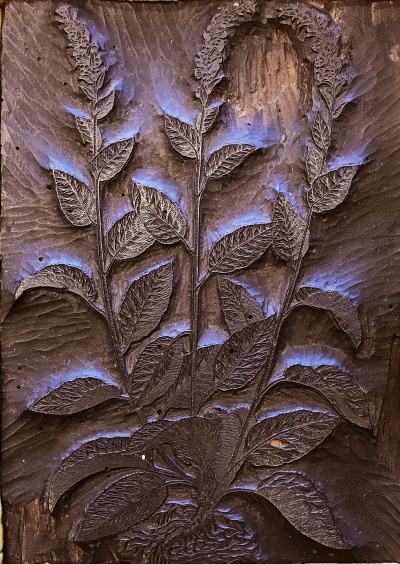
The predominant notion of the historical track of modern science is teleological: this narrative holds that as time passed, accuracy naturally increased, as the pursuit of knowledge solidified in form and texts could increasingly be fact-checked. The primary form of illustration in printed books until the seventeenth century was the woodcut,[1] particularly in illustrated reference works. My essay explores the idea of woodcut book illustration as representative of a burgeoning pursuit of accuracy and therefore of the rise of modern science in the Early Modern period. Through two case studies, Leonhart Fuchs’s De historia stirpium (1542) and Pietro Andrea Mattioli’s commentary on Materia medica, I will attempt to navigate an Early Modern concept of accuracy through the woodcuts of performatively pedagogical books: at first through an assessment of these illustrations’ “accuracy,” but primarily through an interpretation of the work illustrations do in the greater phenomenon of the material book.
In the most basic terms, a woodcut, also known as a woodblock, is a kind of relief print, in which material is removed from a plate to leave a raised design that will then be inked and printed. In woodblocks, material is carved away from a relatively soft plank of wood, traditionally from trees such as pear, apple, and holly.[2] Woodblock printing had existed in China since the 9th century,[3]and had been used in Europe since the early fifteenth century to print playing cards, textile patterns, and blockbooks,[4] in which both the text and the image are carved from the block. The first dated woodcut-illustrated book printed in Europe was the German Der Edelstein in 1461.[5] The first European herbal, the Puch der Natur of Konrad of Megenberg, would be printed in 1475.[6] Woodcut is distinguished from wood engraving, a similar technique on planks cut against the grain, which achieves a much different visual result and would first appear in books as late as the seventeenth century.[7]
Woodcuts would eventually become the primary method of illustrating reference works. The introduction of image reproduction technology to books has, like that of moveable type, been understood as responsible for a “communications revolution.”[8] Elizabeth Eisenstein, in The Printing Revolution of Early Modern Europe, argues that the incorporation of woodcuts into print “helped to revolutionize technical literature:”[9]
Even though block prints and letterpress may have originated in separate innovations and were initially used for diverse purposes, the two techniques soon became intertwined. The use of typography for texts led to that of xylography for illustration.[10]
Preceding Eisenstein is William Ivins, who argues in unambiguous terms that the “exact repetition of pictorial statements has had incalculable effects upon knowledge and thought, upon science and technology, of every kind.”[11] In his view of the technology, he emphasizes the “exactly repeatable pictorial statement” as responsible for massive shifts toward a more capable, more accurate and far-reaching scientific method.[12] These deterministic arguments dominate the conception of woodcuts’ role in the history of science. They paint woodcut illustration as a utilitarian tool for knowledge copying, a type of Early Modern photograph, saving science from the inaccuracies of hand illustration and placing it in a teleological trajectory toward accuracy. Herbals, books that categorized plants in a time where botany and pharmacy were practically interchangeable, form part of this teleological lineage, having existed for millennia before the advent of print but increasing exponentially in numbers afterward.
About as old as illustrated printed herbals, however, are debates over their accuracy. Sixteenth-century physicians contended over both the accuracy and the necessity of pictures in instruction. This was due, according to Sachiko Kusukawa, to disagreements in interpretations of ancient texts. Explicit disapproval by ancients such as Galen and Pliny the Elder and implicit objections by Dioscorides were weighted varyingly by different physicians. While some, like Fuchs and Mattioli, used images to “resolve discrepancies amongst the ancients as well as between the ancients and their own contemporaries,” others “made recourse to philology, history, or morality.”[13] Not only were the pictures themselves disputed, but among those who agreed on their indispensability, contention arose over the effect of the artist’s hand on accuracy. While physicians themselves were not expected to be able to draw, a picture’s accuracy came to depend on the level of physician’s supervision over the artist.[14] We see evidence of this facet of authority in one of the final pages of De historia stirpium, which depicts the artists working under Fuchs’s close watch.
Leonhart Fuchs, De historia stirpium, (1542)
In Leonhart Fuchs’s 1542 herbal De historia stirpium, we see a prime example of the affordances of woodcuts in early reference literature. Fuchs’s herbal accompanies each description of a plant species with a full-page woodcut illustration. This amounts to more than 500 woodcuts, each used only once, in the more than 900 folios of the work.
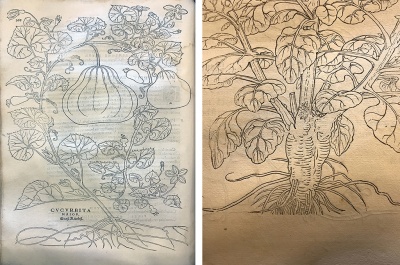
By contemporary standards, the Fuchs illustrations fall short of accuracy in a number of ways. Most of these inaccuracies can be attributed to the existence of an artistic ideal, however subtle. Throughout the book, several artistic decisions exhibit a divergence from a simple copy of the observed plant. The most obvious of these is the rectangularization, in which plants’ extremities are illustrated as bent in order to fit inside the woodblock (sometimes, very rarely, parts of the plant are just cut at the border of the plate, as in the “RAPVM” of page 213; see Figure 1). Rectangularization has the effect of a kind of material landscaping on the page: the natural world is bent and cut to fit an artistic ideal and the technologies affordances?. This creates ambiguity as to the actual direction of the leaves or roots. For example, both the “ACORVM” and the “ANETHVM” are illustrated with roots that bend sideways (see Figure 2). While the “ANETHVM” plant does not naturally have bent roots, and is portrayed as such to fit the block, the “ACORVM” plant does. In one woodcut the choice to bend is one of faithfulness to observed reality and in the other it is one of faithfulness to the design of the page. This ambiguity exemplifies one of the practical effects of the technology at hand: rectangularization allowed for the use of a single plate, which would have saved both time and money.[15] Practically, projections of time and cost played a role in determining the final particulars of portrayed knowledge. We see that the illustrations are necessarily mediated and do not stand alone as vessels of knowledge.
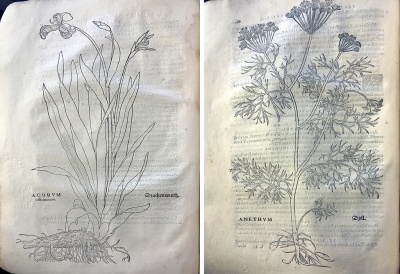
Fuchs’s notion of an ideal further makes subjective the information that is presented as objective. His aversion to strict naturalism in scientific texts informs both the style and the content of the final illustrations. The illustrations have no shading, failing to indicate a possible light source and therefore a range of possible textures. This technique, meant by Fuchs to make the images as clear to interpret as possible,[16] further obfuscates in that the “flat, schematic appearance […] can be visually confusing where the overlapping parts are unmodulated by shading.”[17] These are not photographic representations of the specimens. The illustrations further stray from a strict, naturalistic accuracy in that Fuchs chose not to represent individual, observed specimens, but to omit what he interpreted as imperfections to produce a conglomerate representation of the whole species.[18] Thus, the final image is not a simple copy of an observed reality, but a synthesis that is necessarily interpretive, and therefore subjective.
However, through these subjective decisions toward an ideal, as well as through a number of material, bibliographic choices, Fuchs’s herbal seeks to define rather than to defy a scientific accuracy. According to Kusukawa, these illustrations work not as mere visual representations of a thing, but as “visual arguments” that “len[d] authority” to Fuchs’s scientific views.[19] They were used to “make generalizing arguments, discuss complete or ideal objects, and claim authority in matters of knowledge.”[20] After all, Fuchs was a field botanist[21]; he created De historia stirpium out of frustration over German medicinal ignorance.[22] He wanted an accuracy he wasn’t finding elsewhere. His choices meet an audience expecting not to find photographic reality on the page, but to be convinced, and his “visual arguments” were part of the convincing. Thus, the choice to produce a generalized representation of a species is an argumentative one; in a sense, “this is the plant, not a plant.” As, according to Valerie Traub, Early Modern cartographers sought to map the “habit” of a people,[23] so too did Fuchs seek to present the “character and habit” of a plant species.[24] This practice of generalization would come to be preferred over minute specificity in later herbals.[25] Fuchs, then, defined this facet of accuracy not only for himself, but for herbalists to come.
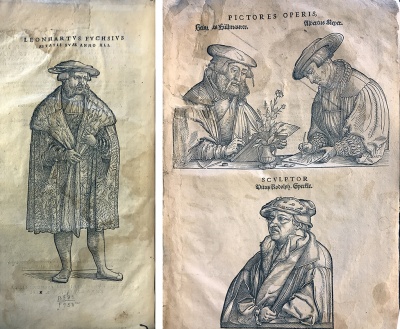
In addition to decisions of visual representation, accuracy in the material text is further defined through distinct markers of authority. The first woodcut illustration of the work is a full-body portrait of Fuchs himself (see Figure 3); before any information is divulged, the reader must acknowledge the maker. The portrait itself is a statement of authority: Fuchs stands holding a plant specimen. This works for him in two ways: Fuchs the doctor is validated through his own representation in his claims to knowledge, and the 900 folios of information that follow are in turn validated by his authority. This authority is reestablished in the final woodcut of the work: the famous portraits of the artists Heinricus Ful̈lmaurer and Albertus Meyer at work (see Figure 3).[26] This portrayal of the artists working under Fuchs’s close supervision asserts that the images are as informed and accurate as possible, having been made through as small a degree of separation from Fuchs’s superior knowledge. Through this cut, Fuchs’s authority as a responsible physician and educator is reestablished, and the hundreds of preceding illustrations are secured in their accuracy.
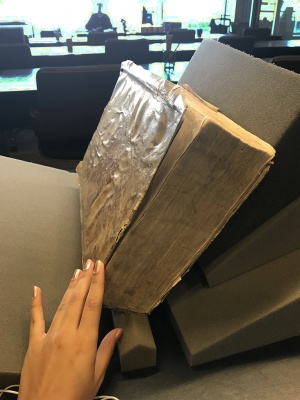
Authority in the material text is further established through a physical sensation of abundance. The book as an object insists on an abundance of knowledge through a profusion of textual, visual, and literal weight. Not only is there an incredible visual mass of text, but this text is accompanied by extensive organizational paratexts. An index lists all the plant specimens in each of three languages; before this, a glossary defines terms. While the index and glossary play practical roles (to facilitate navigability and understanding), they also inform the sensation of reading. The index implies that the knowledge is so extensive that it must be organized, so much so that the organization itself is formidable. The glossary asserts that the information to come is advanced enough that it requires previous knowledge, and urgent enough that it cannot pause to define this information within the text. Thus, a textual organization implies abundance. Moreover, De historia stirpium as an object is in itself impressive (see Figure 4). It carries massive both visual and literal weight: the hundreds of full-page illustrations in full color would’ve created an abundance of visual noise[27]; the bound book is about 900 folios in size and more than a foot in length, and accordingly a hefty weight. It is hard to imagine an Early Modern field botanist taking this anywhere other than his coffee table. In all, there is an extraordinary amount of book. This abundance of book establishes an authority and urgency of knowledge, which defines and insists on the scientific accuracy of the text.
Pietro Andrea Mattioli: Commentary on the Materia Medica, (1563, 1565, 1568, 1600)
Of the most well-known herbals, both now and in its time, is Pietro Andrea Mattioli’s commentary on the Materia medica of ancient Greek physician Dioscorides (date). Mattioli’s herbal, like Fuchs's, takes full advantage of woodcut technology for reference purposes. Almost every page of the more than nine hundred folios (in some cases, as in the 1568 Latin edition, more than one thousand) contains a woodcut illustration. Further, through its more than 60 editions and dozens of thousands of copies,[28] the Mattioli herbal exemplifies the extreme reproducibility of the woodcut and its potential to create uniformity among texts.
Despite Mattioli’s resulting fame as a celebrity doctor after the success of his herbal,[29] by Fuchs’s standards, this herbal would’ve been a disaster of scientific accuracy. In comparing the two, we see flaws in the notion (argument) that scientific illustrations only increased in photographic accuracy as time passed. Mattioli had no working knowledge of plants.[30] Often, he had no specimens to work from, would accept dried plants that then had to be reconstituted to observe, and would copy illustrations with no means of checking with the original plant.[31] Further, the illustrations in Mattioli’s herbal are as beautiful as they are inaccurate. Throughout the work, it is often obvious that the “illustrator has not properly understood the construction” of the specimens.[32] These illustrations held great appeal for the many thousands of contemporary readers,[33] and were perhaps made with this readership in mind; we see here, more so than in Fuchs’s, illustrations toward an artistic ideal.
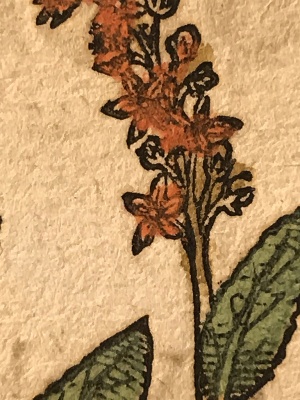
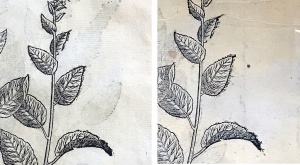
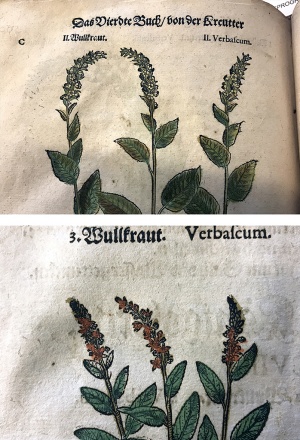
Artistry seems to take the reins in much of the illustrations. Mattioli’s herbal is infamous for its rectangularization.[34] Roots and leaves conspicuously turn inwards and press against an invisible border in nearly every illustration. Further, in stark contrast to Fuchs’s simplifying illustrations, here the “artist has over-elaborated his subject” to the point of confusion.[35] The pictures are heavily shaded and textured to point of obfuscation. So too do the colors conceal. The paints bleed past woodcut borders and obscure outlines by nature of their thickness (see Figure 5). Further, different editions differ in illustrations of the same plant. Sometimes this is subtle, as in the 1565 and 1568 Latin editions. One can see that the same woodblock of the “VERBALCUM” has been printed with different pressures: the 1565 picks up noise from the plate that isn’t apparent in the 1568 (see Figure 6). More conspicuously, the different editions are, in a way revelatory of the lack of supervision across editions and languages, colored differently to represent the same plants. For example, the 1600 German edition paints the “VERBALCUM” flowers red where in the 1563 German edition they are an almost imperceptible light yellow (see Figure 7). In these two woodcuts we further see differences in the “accuracy” of illustrations throughout editions. The 1600 edition of the “Verbalcum” woodcut, an imitation of the 1563 “Verbalcum” and exactly half its size, changes not only the color, but the shape of the flowers. Where in the 1563 they are rounded, in the 1600 they are clearly pointed (see Figure 7). Which is more accurate? Which should the Early Modern reader question? It is unlikely that an Early Modern reader would have had access to more than one of Mattioli’s herbals. The woodcuts in each copy, then, stand alone as unquestionable, authoritative representations to their readers.

Despite their major differences, the Mattioli herbal and De historia stirpium define accuracy in very similar ways. As Fuchs worked to update German medicinal knowledge, Mattioli sought to update Dioscorides’s Materia medica with contemporary information.[36] Explicit in the opening paratexts, this endeavor, like Fuchs’s woodcut portrait, works in two ways to validate the text. It validates Mattioli as both a sound follower of ancient wisdom and a contemporary physician presenting the most up-to-date information possible. His authorship, in turn, validates the text. Likewise, the two herbals assert authority through similar material decisions. The Mattioli herbal is a massive book (see Figure 8): the 1568 Latin edition surpasses 1000 folios; Blunt’s and Raphael’s The Illustrated Herbals warns that “only those accustomed to let their Great Dane sleep on their bed should contemplate choosing the Mattioli folio [...] for a bedside book.”[37] Nearly every page in the massive text is populated by an illustration, this overwhelm of images further contributing to a sensation of abundance. Further, not only is it physically impressive and heavily illustrated, but it also asserts authority in its binding: the 1563 edition is bound in parchment and embossed with an intricate design (see Figure 8). The hard covers are held together by metal clasps that, at least in my experience, require more than one reader to undo (see Figure 8). Finally, like in De historia, the copious amounts of information are indexed extensively. There is a lengthy index of plant species and, at least in the 1568 Latin edition, a practical index of medicinal uses; the text asserts itself not only in amount of information, but in knowledge of its own purpose. Thus, like Fuchs’s, the Mattioli herbal employs textual and material abundance to assert authority, one which implies its own accuracy.
Conclusion
By comparing the two works, we find that woodcut illustrations in Early Modern herbals exist for reasons other than simply copying reality. “Accurate” woodcuts in works that perform objectivity are mediated by realities of the technology such as the limited space of a single block. They are also, primarily, mediated by the author’s notion of an ideal representation. To Fuchs, this representation is a collective, perfect version that synthesizes individual specimens. To Mattioli, this ideal is one that is beautiful, and thereby engaging. Woodcuts further exist in these works not only as mediated representations, but as visual mass to denote abundance. Collectively, the hundreds of woodcuts in the respective herbals form an integral part of the sensation of reading: they contribute to the material text’s physical insistence on its own authority. In this way they form an essential part of each text’s definition of accuracy. In tandem with the work’s look, weight, and author-centric and organizational paratexts, the woodcuts help to define accuracy within these herbals as dependent on authority. Scientific accuracy here is defined not purely by observation and method, but by perceived authorship.
Notes
- ↑ Bamber Gascoigne, How to Identify Prints: A Complete Guide to Manual and Mechanical Processes From Woodcut to Ink Jet (New York, N.Y.: Thames and Hudson, 1986), 5a,b.
- ↑ Edward Hodnett, Five Centuries of English Book Illustration (Aldershot, England: Scolar Press, 1988), 10.
- ↑ Gascoigne, Identify Prints, 5a,b.
- ↑ Hodnett, Five Centuries, 10.
- ↑ Paul Needham, "Prints in the Early Printing Shops." Studies in the History of Art 75 (2009), 55.
- ↑ Wilfrid Blunt and Sandra Raphael, The Illustrated Herbal (New York, N.Y.: Thames and Hudson: Metropolitan Museum of Art, 1979), 113.
- ↑ Gascoigne, Identify Prints, 6a.
- ↑ Elizabeth L. Eisenstein, “Defining the Initial Shift,” The Printing Revolution In Early Modern Europe. 2nd ed. (Canto classics ed. Cambridge: Cambridge University Press, 2012), 24.
- ↑ Eisenstein, “Defining,” 24.
- ↑ Eisenstein, “Defining,” 26.
- ↑ Ivins, William Mills, Prints and Visual Communication. (Cambridge, Mass.: M.I.T. Press, 1953, 1969), 3.
- ↑ Ivins, Prints, 3.
- ↑ Sachiko Kusukawa, Picturing the Book of Nature: Image, Text, and Argument In Sixteenth-Century Human Anatomy and Medical Botany (Chicago: University of Chicago Press, 2012), 20.
- ↑ Kusukawa, Picturing, 24.
- ↑ Blunt and Raphael, Illustrated Herbal, 126.
- ↑ Kusukawa, Picturing, 109.
- ↑ Gill Saunders, Picturing Plants: an Analytical History of Botanical Illustration (Berkeley: University of California Press in association with the Victoria and Albert Museum, London, 1995), 26.
- ↑ Saunders, Picturing Plants, 20.
- ↑ Kusukawa, Picturing, 3.
- ↑ Kusukawa, Picturing, 3.
- ↑ Blunt and Raphael, Illustrated Herbal, 125.
- ↑ rank J. Anderson, An Illustrated History of the Herbals (New York: Columbia University Press, 1977), 137.
- ↑ Valerie Traub, “Mapping the Global Body,” Early Modern Visual Culture: Representation, Race, Empire In Renaissance England. (Philadelphia: University of Pennsylvania Press, 2000), 51.
- ↑ Blunt and Raphael, Illustrated Herbal, 126.
- ↑ Saunders, Picturing Plants, 22.
- ↑ Kusukawa, Picturing, 107.
- ↑ Anderson, Illustrated History, 146.
- ↑ John Bidwell, Mattioli's Herbal: A Short Account of Its Illustrations, with a Print From an Original Woodblock (New York: Pierpont Morgan Library, 2003), 5.
- ↑ Anderson, Illustrated History, 164.
- ↑ Anderson, Illustrated History, 168.
- ↑ Anderson, Illustrated History, 168.
- ↑ Saunders, Picturing Plants, 31.
- ↑ Anderson, Illustrated History, 170.
- ↑ Saunders, Picturing Plants, 31.
- ↑ Saunders, Picturing Plants, 33.
- ↑ Anderson, Illustrated History, 170.
- ↑ Blunt and Raphael, Illustrated Herbal, 133.